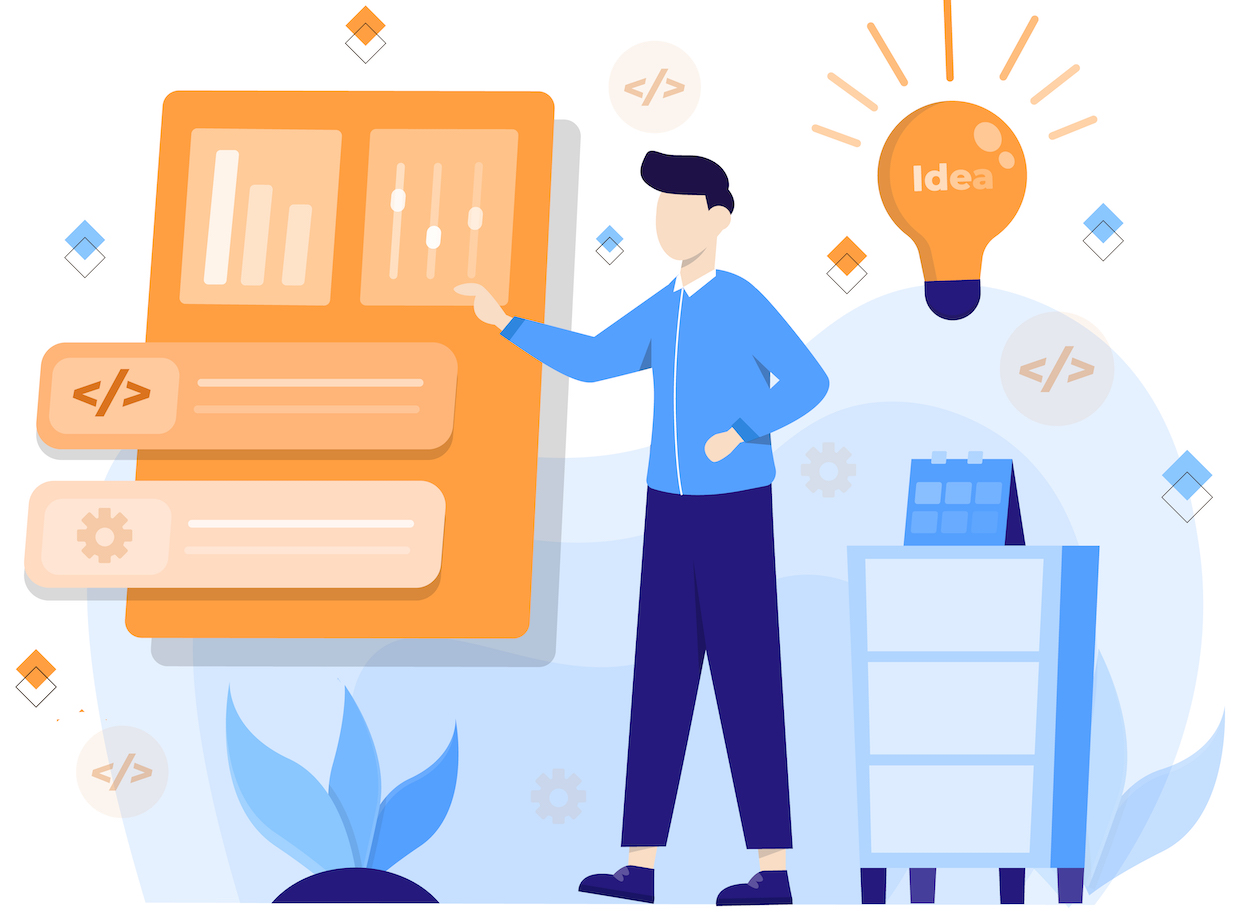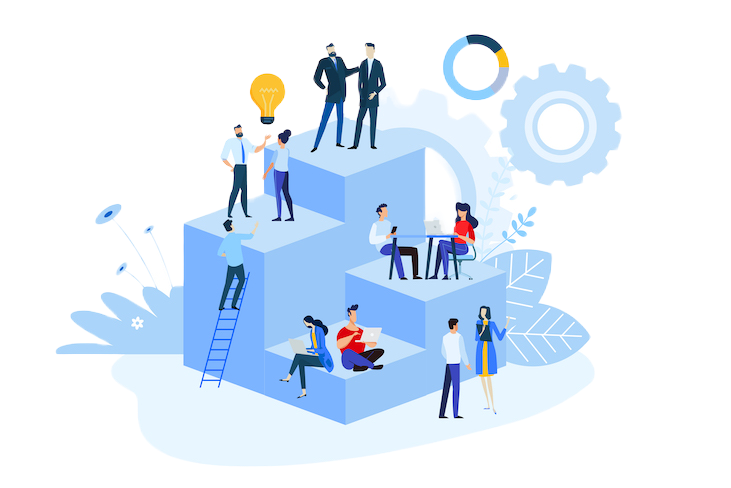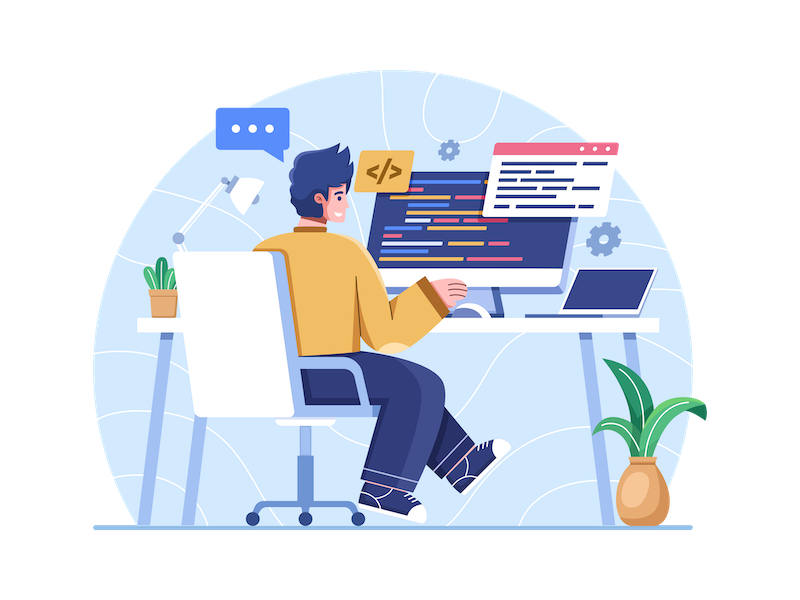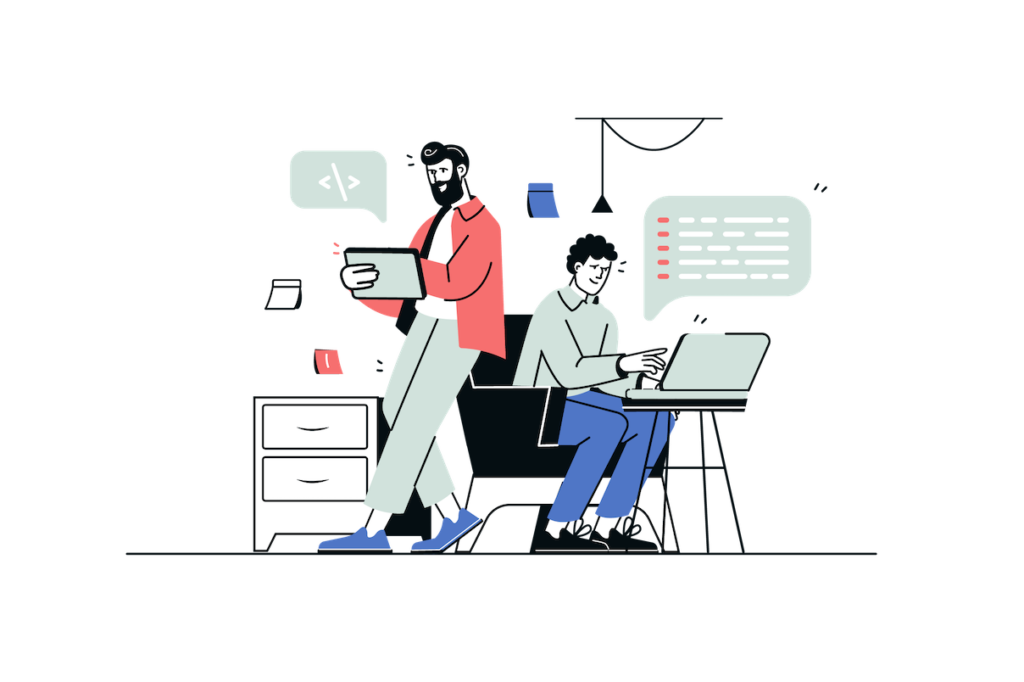Angular Developer
Master the Most Sought-After Skills in Web Development
Tier-1 Software Engineer Bootcamp
5 Months
Integrated Bootcamp
Keystone Project
Beginner to Expert
Placement Assured
The front-End Web Developer Angular Bootcamp
Building a strong foundation in Modern Web Development
Dive into the Angular Developer Integrated Bootcamp and embark on an unparalleled journey from a beginner to a front-end maestro. This comprehensive training program is meticulously designed to transform fresh graduates into seasoned Angular developers.
Beyond mere coding, this bootcamp encapsulates real-world application development, systematic mentorship by veteran developers, and mastery over essential software tools and agile methodologies. Experience hands-on project execution and understand the intricacies of the software development life cycle.
You will start with a strong focus on fundamental concepts, ensuring a solid foundation in web development, software engineering, and UI/UX Designing before progressing to learning Angular, the leading frontend framework.
Read Article: Why Joining an Angular Bootcamp is Your Next Best Career Move!





- What is Angular
- What Makes Angular a Top Choice?
- Web Front-end Developer as a Career
- Program Objectives
- Skills Learned In The Bootcamp
- Technologies, Tools & Frameworks Involved
- Angular Bootcamp - Program Structure
- Training Methodology
- Why Choose Aitrich Academy
- Beyond Front-End Web Development -Angular
- Who is Eligible?
- Join Angular Developer Bootcamp Now!
What is Angular?
Angular is the leading framework powering web development, offering a world of possibilities for aspiring tech professionals. By acquiring Angular skills, you open the door to a vast array of exciting career opportunities. Companies across industries are actively seeking Angular developers, making it a highly in-demand skillset.
Boost Your Employability with Angular
Stay Ahead in the Dynamic Tech Industry
The tech industry is ever-evolving, and staying ahead of the curve is crucial for career growth. By investing in learning Angular, you position yourself as a forward-thinking professional who embraces new technologies and keeps up with industry trends. Angular’s continuous updates and active community ensure you remain at the forefront of web development, paving the way for long-term success.
Mastering Angular gives you a competitive edge in the job market. With Angular expertise, you become an attractive candidate for employers looking to build robust web applications. Stand out from the crowd and increase your chances of landing lucrative positions with companies that rely on Angular for their frontend development needs.

What makes Angular a top Front-end Framework?

Angular, a brainchild of Google, is a leading open-source framework designed specifically for crafting dynamic single-page applications (SPAs). Here’s why it’s a game-changer in front-end development:
- Rich UI: Its component-based design ensures interactive and modular user interfaces.
- Two-Way Data Binding: Real-time updates are seamless, eliminating manual DOM interventions.
- Efficiency Boosters: Integrated practices like Dependency Injection make scalable applications straightforward.
- Expansive Ecosystem: From UI libraries to debugging tools, Angular’s vast community offers immense resources.
- Future-Forward: Constantly evolving, Angular ensures its developers are always equipped with cutting-edge web tools.
Angular is the bedrock for modern, efficient, and future-ready web development.
Web Front-end Developer as a Career
Stepping into the world of web development, particularly as a front-end developer, unlocks a blend of creativity and technology with promising potential. Here’s a snapshot of why:
- Rising Demand: The wave of digitalization has led to an increased need for web presence, putting front-end developers at the heart of this digital transformation.
- Evolving Trends: The focus on user experience and emerging technologies, from Progressive Web Apps to AR/VR, keeps the role of a front-end developer ever-relevant.
- Attractive Salaries: Their unique skills command competitive salaries, with growth in expertise translating to growth in earnings.
- Global Reach: Front-end development skills are universally valued, opening doors to opportunities worldwide.
- Bright Future: With innovations like 5G and AI shaping the web, front-end developers will be the main architects of tomorrow’s digital world.
- Entrepreneurship Opportunities: Many front-end developers evolve into entrepreneurs, leveraging their digital expertise to start ventures or offer services.
In essence, a career in front-end development isn’t just a job but a dynamic journey in the ever-progressing digital realm.

Program Objectives



Discover the enriching benefits and outcomes the Angular Developer Integrated Bootcamp promises to deliver, ensuring you emerge as a sought-after front-end developer.
- Solid Web Foundation: We don’t just teach; we ensure you master the basics of HTML, CSS, and JavaScript. This strong foundation ensures that you’re always a step ahead in the industry.
- Mastering Angular: Beyond just skills, we aim to instill expertise. With our program, you’ll emerge as an Angular connoisseur, ready to tackle challenges and deliver groundbreaking solutions.
- 360° Developer Evolution: It’s not just about coding; it’s about crafting solutions. Experience every facet of software development, from ideation to deployment, ensuring you’re a holistic developer.
- Hands-on Real-world Experience: What’s learning without application? Our keystone projects promise real-world challenges, ensuring you graduate not just with knowledge, but also with invaluable experience.
- Agile Excellence: Dive deep into Agile methodologies. Not just the theory, but the practical implications, preparing you for the dynamic world of modern software development.
- Best Practices & Precision: Embrace the nuances of software engineering, adopting best practices that ensure your code isn’t just functional, but is a benchmark of quality and efficiency.
- Collaboration & Communication: Beyond coding, unlock the art of team dynamics. Learn to be an effective communicator, a team player, and a project leader.
By the end of the bootcamp, you’ll not only have a skill set but a transformative experience that ensures you stand out and excel in the Angular development sphere.
Skills Learned in the Bootcamp
Dive into an intensive journey where you’ll:
- Web Mastery: Grasp the core of web front-end development, ensuring interactive and user-friendly designs.
- Mobile Responsiveness: Equip yourself with mobile-first design techniques, crucial for today’s varied device users.
- UI/UX Excellence: Learn the art of creating intuitive interfaces and smooth user experiences vital for successful applications.
- SPA Exploration: Understand the dynamics of Single Page Applications, the modern approach to web application development.
- Angular & TypeScript: Master the renowned web framework Angular, backed by the statically-typed JavaScript superset, TypeScript.
- Test-First Approach: Embrace Test Driven Development, ensuring robust and efficient applications.
- API Crafting: Design impeccable APIs with OpenAPI and Swagger, tools that dominate the current tech landscape.
- Deployment Insights: Delve into CI/CD strategies for timely software upgrades and impeccable quality.
- Clean Code Practices: Understand the essence of design patterns and coding best practices, enhancing maintainability.
- Software Engineering Depth: Cover all phases of software engineering, from requirement gathering to system design.
- Agile Deep Dive: Go beyond the basics, understanding the profound benefits and techniques of Agile methodologies.
- Front-end Blueprint: Learn the architectural nuances critical for scalable web applications.
- APIs & Real-Time Web: Master API integration and the real-time capabilities of WebSockets.
In essence, this bootcamp offers more than just coding techniques. It molds you into a holistic web developer, aligned with industry demands and poised for future front-end challenges. Prepare not just for a job but for an impactful career in front-end development.
Technologies, Tools and Frameworks Involved
The Angular Developer Integrated Bootcamp aims to make you proficient in the most current and in-demand tools of the industry. Here’s an in-depth overview of what participants will get acquainted with:
Web Stack:
HTML-5 & CSS-3: The foundation stones of the web, they form the essence of web structure and design, ensuring every webpage is semantically accurate and visually striking.
JavaScript: The programming language of the web, it’s crucial for adding interactivity and dynamic behavior to websites.
Responsive Web Design: Essential in today’s multi-device world, it ensures that web applications provide an optimal viewing experience across a wide range of devices.
Bootstrap: A powerful front-end framework that makes web development faster and easier, especially with its mobile-first and responsive design capabilities.


Single Page Application Development:
Revolutionizing the user experience, SPAs load a single HTML page and dynamically update as the user interacts with the app.
- TypeScript: An enhancement over JavaScript, it adds optional types, classes, and modules to JavaScript, making it more scalable and maintainable.
- Angular: A top-tier web application framework, Angular is instrumental in building dynamic and modern web applications.
- RxJS: A library for reactive programming, it’s pivotal for developing asynchronous web applications with dynamic data streams.
Automated UI Testing:
- Test Driven Development: Adopt a proactive approach to software development. Learn the importance of writing tests before actual coding, ensuring that your applications are robust, efficient, and bug-free.
- Jasmine, Karma & Protractor: These tools together form a powerful suite for testing Angular applications. While Jasmine and Karma focus on unit tests, Protractor specializes in end-to-end testing.


Build & Deployment:
- Angular CLI: A command-line interface for Angular, it’s essential for initializing, developing, scaffolding, and maintaining Angular applications.
- Npm: The package manager for JavaScript, it’s critical for managing project dependencies and scripts.
- AOT (Ahead-of-Time) compilation: A compilation process that boosts the performance of Angular apps by compiling them at build time.
- Webpack: An essential module bundler and task runner, it optimizes and packages code for deployment.
- Docker: Revolutionizing software containerization, it ensures consistent environments from development to production.
Tooling and Environment:
Git & Github: While Git offers version control, Github provides a platform for repository hosting, ensuring collaborative and version-controlled development.
Visual Studio Code (VS Code): A feature-rich code editor, VS Code offers an optimal environment for web development with its extensive extension support.
Project Management:
Trello & JIRA: Vital tools for agile project management, they assist in tracking progress, managing backlogs, and ensuring smooth team collaboration.

UI/UX Development:
- Figma: A vector graphics editor and prototyping tool, Figma is essential for designing interactive UIs with a focus on user experience.
API Design & Documentation:
- OpenAPI & Swagger: Together, they form a formidable duo for designing, building, and documenting RESTful web services.
With exposure to this comprehensive array of tools and technologies, participants are not just getting trained; they’re getting industry-ready. Our bootcamp promises depth, ensuring every participant is well-equipped to be at the forefront of the modern web development world.
Angular Developer Bootcamp - Program Structure
Embarking on a transformative journey in the realm of web development requires a sturdy foundation. The Angular Developer Integrated Bootcamp kickstarts with a comprehensive orientation phase, designed to set the stage for what’s to come.
Embarking on a transformative journey in the realm of web development requires a sturdy foundation. The Angular Developer Integrated Bootcamp kickstarts with a comprehensive orientation phase, designed to set the stage for what’s to come.
- Student Onboarding: An inviting start for every budding developer, this segment ensures that students get acquainted with the program’s expectations and objectives.
- Keystone Project Overview: Gain insights into the main software product to be developed during the course, offering a sneak peek into the holistic application of the learning objectives.
- Technology and Tools Walk-through: A panoramic view of the extensive technology stack and tools that will be utilized, familiarizing students with the playground they’re about to step into.
- Intro to Training and Development Methodologies: Understanding the ‘how’ is as crucial as the ‘what’. This segment unravels the methodologies that will be employed throughout the program.
- Illustration of the Outcome: Visualization aids motivation. A preview of what participants will accomplish by the end of the program brings clarity and stokes the excitement.
The next phase helps to equip students with the foundational pillars of project management, ensuring not only technical prowess but also a strategic mindset.
- Tools Sign-up:
- Trello Introduction: Dive into the world of agile project management with Trello, learning the ropes of task tracking and team collaboration.
- Github Intro: A cornerstone for modern developers, GitHub offers version control and collaborative features that streamline the software development process.
- Project Scope of Work & Brainstorming: This collaborative phase encourages students to thrash out ideas, refining them into actionable items that set the trajectory for the development process.
- Product Backlog Creation and Estimation: An essential agile practice, the creation of a product backlog, ensures all features are accounted for, prioritized, and estimated appropriately.
- Project Milestones and Delivery Plan: By breaking down the development journey into tangible milestones, this step ensures clarity of vision and timely execution.
Dipping toes into the vast ocean of software engineering begins here. Students gain a conceptual framework to appreciate the science and art behind building robust software.
- Software Systems Overview: Grasp the broad picture of how different software systems communicate, function, and serve various purposes.
- Operating Systems & Networking Concepts: Delve into the backbone of computing, understanding the intricacies of OS and how data flows in the interconnected digital ecosystem.
- Software Engineering Roles & Responsibilities: Gain insights into the diverse roles within a software team, from developers to quality analysts, each playing a pivotal role in the software lifecycle.
- SDLC – Software Development Life Cycle: Understand the stages involved in bringing a software project from conception to completion, laying the foundation for upcoming detailed modules.
- Agile Methodologies: Transcend traditional development approaches and embrace the iterative and collaborative approach of Agile, setting the stage for an adaptive and responsive development process.
- Git Fundamentals: Learn the essentials of Git, the de-facto version control system, ensuring every line of code is tracked, collaborated upon, and integrated seamlessly.
This first part of our comprehensive program structure aims to lay a solid foundation for our participants. It sets the scene for the more specific, technology-driven modules that follow, ensuring a smooth and informed transition into the intricate world of web development. Stay tuned for Part 2, where we’ll delve deeper into the realms of Requirements Engineering, UI/UX Designing, and more!
The bedrock of any successful software product is its ability to meet the user’s needs. Requirements engineering emphasizes understanding, defining, and documenting these needs in a structured manner.
- Agile Requirements: Understand the fluid and dynamic nature of requirements in an Agile setting, ensuring adaptability and consistent alignment with user needs.
- Creating Use Case Diagrams for the System: Visual representations often convey a lot more than text. Learn to distill system requirements into intuitive use case diagrams that provide a clear overview of functionalities and interactions.
- Creating User Stories for the System: Dive into the art of crafting user stories – succinct, user-centric declarations that guide feature development in alignment with user needs.
- Creating SRS – Software Requirements Specification: Detail every nuance of the system’s requirements in a structured document, ensuring clarity and completeness.
- Product Backlog Grooming: Refinement is key. Periodically revisit the product backlog to reprioritize, re-estimate, and ensure it remains aligned with the project’s objectives.
- Creating a Release & Sprint Plan for the System: Break down the development timeline into manageable sprints, planning releases to deliver value incrementally and consistently.
In the digital era, user experience is paramount. A software application should not only be functional but also intuitive and visually appealing.
- Intro to UI/UX Process & Figma: Embark on the fascinating journey of user-centric design, utilizing Figma as the tool of choice for crafting digital experiences.
- Building Low-Fidelity Wireframes using Figma: Before diving deep, sketch out your ideas. Create rough blueprints of your web pages, laying the groundwork for detailed designs.Building High-Fidelity Mockups using Figma: Convert your wireframes into detailed, pixel-perfect mockups that serve as the reference point for development.
A successful software product is backed by meticulous planning and structuring. System analysis and design provide a blueprint, ensuring every piece falls into place perfectly.
- System Analysis & Design Overview: Dive deep into the methodologies and processes involved in analyzing and designing robust systems.
- Domain Modeling: Domain Modeling Part-1: Understand the specific area of interest or sector the software caters to and model it to ensure accurate representation and functionality.System Architecture: System Architecture Part – 1: Delve into the structural design of systems, understanding components, their relationships, and how they integrate seamlessly.
Front-end development is where the magic happens – where code transforms into interactive, visual interfaces that users interact with.
- Web Development and Web Applications: Get introduced to the world of web development, understanding the difference between static sites and dynamic web applications.
- Basic Concepts of Web Servers and Web Clients: Grasp the foundational knowledge of how servers and clients communicate in the digital realm.
- Web Protocols – HTTP, HTTPS, and more: Understand the rules that govern data transfer on the web, ensuring secure and efficient communication.
- Basic Structure of Web Pages, Including HTML & CSS: Delve into the building blocks of the web, understanding the role and structure of HTML and CSS in web design.
- Front-end Programming Using JavaScript and JQuery: Embrace the power of JavaScript, complemented by the convenience of JQuery, to breathe life into static web pages.
- Popular Web Development Frameworks and Libraries: Get a taste of the various tools and frameworks available to modern developers, setting the stage for in-depth exploration.
- Building the Product Web Front-End using HTML, CSS & JavaScript: Transition from theory to practice, crafting an actual web front-end using the foundational trinity of web development.
- Building Responsive Web Applications Using Bootstrap: In a mobile-first world, responsiveness is key. Learn to craft fluid designs that adapt seamlessly to varying screen sizes using Bootstrap.
As we conclude Part 2 of our program structure, we’ve ensured that our participants are well-versed in the foundational elements of software development, from requirements to design and front-end development. In Part 3, we’ll deep-dive into the realm of Angular, exploring its intricacies, advanced topics, and how to leverage its power for robust web application development.
Angular stands tall as one of the premier frameworks for front-end development, offering robust solutions for single-page web applications.
- Single Page Applications (SPA): Discover the paradigm shift from traditional web applications to SPAs, enhancing user experience through fluid, dynamic content changes without page reloads.
- Angular Fundamentals: Begin your Angular journey with a solid grasp on its core concepts, setting the foundation for more complex topics.
- Angular Application Architecture: Delve into how Angular applications are structured, from modules to components, and how they all come together.
- TypeScript Fundamentals: TypeScript, a super-set of JavaScript, offers static typing. Understand its significance and integration within Angular.
- New Angular Project Using Angular CLI: Get hands-on, setting up your first Angular project using the Command Line Interface.
- Understanding the tsconfig.json File: Dive into the configuration specifics of your Angular project, ensuring optimal settings for your development needs.
- Components, Modules & Decorators: Grasp these essential building blocks of Angular, from breaking down your application into components to organizing them within modules.
- Directives, Lifecycle Hooks & View Encapsulation: Delve deeper into advanced Angular concepts, mastering the tools that give you greater control over your application’s behavior and presentation.
- Templates, Data Binding, and Directives: Seamlessly connect your application’s logic with its presentation, ensuring dynamic and interactive user experiences.
- Angular Forms & Templates: Master the tools and techniques to capture user input, from basic form controls to complex form groups and validation.
- Reactive Forms & Validation: Go a step further with reactive forms, offering more flexibility and control, especially for complex forms and validations.
- Angular Routing & Navigation: Learn to manage navigation within your application, creating intuitive and user-friendly flows.
A quality-first approach can significantly improve the longevity and reliability of applications.
- TDD & Unit Testing Fundamentals: Embrace the philosophy of drafting tests before actual code. Understand its significance in ensuring every code change or addition remains robust and efficient.
- Automate UI Testing Using Karma & Jasmine: Simplify the testing landscape of your Angular applications by leveraging Karma as your test runner and Jasmine as the heart of your testing framework.
- Unit Tests for Components, Services, and Pipes: Dive deep into crafting unit tests that cover every nook and cranny of your application, from simple components to intricate services.
- Mocking Dependencies and Handling Asynchronous Operations: Master advanced testing techniques, from mocking external dependencies to efficiently testing asynchronous operations.
- Automatic UI Testing Using Selenium: Further automate the testing process, employing Selenium for user interface tests, simulating real-world user interactions.
Hands-on is the best way to learn. Here, we’ll develop a flagship project encompassing everything learned so far.
TODO: Expand here
- Project Setup to Final Deployment: From initializing the project, crafting individual features, to deploying the final product, experience a full development cycle.
Well-designed APIs can dramatically enhance the performance and usability of applications.
- Restful API Design Fundamentals: Deep dive into the principles of REST and the best practices that ensure your APIs are not only functional but also scalable and intuitive.
- Swagger & Open API: Empower your API design process with tools like Swagger and OpenAPI, ensuring they adhere to industry standards and are designed with both the developer and end-user in mind.
This segment further solidifies the core concepts surrounding Angular and front-end development, ensuring participants possess both theoretical knowledge and the practical skills needed in the real world.
Angular’s vastness brings with it advanced features and techniques that can amplify an application’s performance, maintainability, and user experience.
- Services and Dependency Injection: Delve into the heart of Angular’s service layer. Learn how services offer a consolidated platform for logic and data, and how Dependency Injection facilitates modularity and reusability.
- HttpClient and API Integration: Connect your Angular application to the world. Explore the HttpClient module, diving deep into making API calls, handling responses, and managing errors efficiently.
- RxJS Basics, Observables, and Operators: Embrace the reactive paradigm. Master the core concepts of RxJS, learn about observables, and explore operators that can transform and shape data streams in real time.
- Error Handling: Equip yourself to gracefully handle unexpected situations. Understand the best practices for error handling in Angular, ensuring a seamless user experience even when things go awry.
Go beyond the basics to master the advanced features that Angular offers.
- Angular Material, NGX Bootstrap, etc.: Introduce yourself to a suite of UI component libraries that can drastically improve your application’s look and feel.
- Applying Bootstrap Theme Inside Angular Application: Seamlessly integrate Bootstrap themes within Angular, ensuring a consistent and responsive design.
- Animations in Angular: Breathe life into your applications. Learn the art of crafting fluid animations, enhancing user interactivity and engagement.
- Web Sockets and Real-time Updates: In an ever-connected world, real-time data is paramount. Dive into WebSockets and learn how to maintain persistent two-way communication between the server and client.
- Progressive Web Apps (PWAs) with Angular: Step into the future with PWAs. Understand how to transform your Angular application into a PWA, reaping the benefits of offline capabilities, push notifications, and more.
- Angular Best Practices & Design Patterns: Write Angular code that stands the test of time. Learn about design patterns, coding standards, and best practices that ensure maintainability and scalability.
- Angular Style Guide: Consistency is key. Familiarize yourself with the Angular style guide, ensuring that your code is both readable and adheres to best practices.
Translating your Angular codebase into a live application is an art in itself. Dive deep into the processes that take your application from development to deployment.
- Understanding the Build Process with Angular CLI: The Angular CLI is more than just a tool for initializing projects. Learn how it plays a pivotal role in building and optimizing your Angular applications.
- AOT (Ahead-of-Time) Compilation: Supercharge your application’s startup speed with AOT. Dive deep into the benefits of pre-compiling Angular components and understand its edge over Just-In-Time (JIT) Compilation.
- Deploying the Angular App to Cloud – AWS/Azure: Once your app is ready, the world should see it. Learn the process of deploying your application onto leading cloud platforms like AWS and Azure, ensuring scalability and availability.
In this segment, participants explore the advanced nuances of Angular, touching on areas that often distinguish a seasoned developer from a novice.



Training Methodology
This program follows Aitrich Training Methodology(ATM), which is designed to provide a real-life software engineering experience to the students.
ATM – A Specialized Learning Methodology:
ATM is a specialized learning methodology that follows standard software engineering principles and practices as part of the whole learning process. It is based on a project-based, team-oriented, and instructor-led approach that emphasizes collaboration, problem-solving, and continuous improvement.
Key-stone Project based Learning:
The entire program is designed around a software project that develops a real-life application and the whole batch of students are organized as the team members who develop the system. The team will follow agile methodologies such as SCRUM, and software engineering principles and practices as part of their daily tasks. As the program progresses towards the end, the project will be fully developed by the team members.
At the end of the program, the students will have all the skills of an experienced software engineer who can undertake serious software projects with a sense of ownership.


Why Choose Aitrich Academy?


In the ever-evolving landscape of technology, the right educational foundation can be the distinguishing factor between a typical career and one that’s truly exceptional. When considering an institution to shape your tech aspirations, it’s imperative to choose one that not only educates but also empowers. Enter Aitrich Academy.
- Pioneering Legacy: As a key arm of Aitrich Technologies, we’re backed by a history of leading-edge software innovation.
- Transforming Freshers into Experts: Over a decade in the field, we’ve consistently turned budding tech enthusiasts into industry leaders, boasting a formidable 95% placement rate.
- Mentorship by Industry Stalwarts: Our trainers are seasoned professionals, offering a blend of theoretical depth and real-world insights.
- Tailored, Industry-driven Curriculum: Our courses are not mere syllabuses; they’re industry-driven blueprints, crafted to meet the ever-evolving demands of the tech world.
- Testimonials & Partnerships: Our alumni success stories and collaborations with top-tier IT companies attest to our excellence and influence in the tech training domain.
At Aitrich Academy, we don’t just offer well-crafted Training Programs; we pave pathways to tech leadership. Embark on your journey with us.
What other essential Software Engineering skills you earn from this program
Beyond Front-End Web Development -Angular
Since this training program is following Aitrich Training Methodology, this program will have the following salient features, besides the technical topics covered:
The Training Program is conducted as a project-based training program, allowing participants to apply what they have learned through hands-on experience with real-world projects. Participants will develop an end-to-end software project using all the topics they’re learning in the training incrementally, throughout the course of the program. This will provide the participants with all the skills required to become confident Java Developers who can join any professional software team.
The training program follows Agile development methodologies and uses SCRUM for project management and Kanban for tracking progress. This allows the participants to experience and practice professional software engineering disciplines and practices in the real world.
The training program is designed to foster teamwork, collaboration, and communication among participants, mirroring real-world team environments. The roles and responsibilities they handle on a daily basis as part of the learning and project development will make them natural teamsters and often leaders.
The training program emphasizes the use of Extreme Programming (XP) practices such as Test-Driven Development (TDD), Pair Programming, and Continuous Integration and Delivery.
The training program covers the principles and practices of Domain-Driven Design (DDD), an approach to software development that focuses on the core domain and business logic of the application.
The training program covers the use of Unified Modeling Language (UML) and other tools for architecture and system design, helping participants develop a deeper understanding of how to design and develop high-quality, scalable software systems.
The training program leverages the power of professional software development tools such as Git for Source Control, Trello for Task Management and Jira for Issue Tracking. This will allow the students to get familiar with these essential tools for standard software engineering in professional organizations.


Who is Eligible for the Angular Developer Bootcamp?



The world of technology is vast, diverse, and ever-evolving. Just as diverse is the array of individuals who have the passion, drive, and capability to thrive in it. At Aitrich Academy, we recognize the potential in every enthusiastic learner. If you’ve got the zest for programming and a vision to carve a niche for yourself in the IT industry, our bootcamp could be your ideal launchpad.
A Glimpse into the Eligibility Criteria:
If you’ve recently completed your schooling and are looking to dive straight into the tech world, this program offers a comprehensive foundation and head-start into a career in IT.
Whether you hold a BSc, BCom, B.Tech, BE, BCA, or even a BA, this bootcamp can elevate your foundational knowledge and equip you with specialized skills tailored to the IT industry’s demands.
With a solid base in technical education, Polytechnic graduates can further hone their skills and gain an edge in the competitive IT sector.
For MCA graduates or those with a similar master’s degree, this program offers an opportunity to keep pace with the latest industry trends, sharpening both your theoretical knowledge and practical skills.
If you come from a non-IT background but possess a flair for programming and a strong desire to switch lanes into the tech industry, this bootcamp can be your bridge to that transition. Your diverse perspective combined with our in-depth training can lead to unique and innovative solutions in the tech world.
For those who have dabbled in programming or tech-related hobbies on their own, this program can offer structured learning and industry-aligned methodologies to take your passion to a professional level.
Ready To Kickstart Your Tech Career?

Irrespective of your academic background, if the world of coding beckons you, Aitrich Academy welcomes you with open arms.
Shape your future in tech, starting today!
we will contact you back within 24hrs
Students testimonial
Discover the Inside Scoop
Hear From Students Themselves






Similar Training Programs

Enterprise Java Developer
Enterprise Java Developer is a comprehensive course that covers Java enterprise development concepts and technologies. It is designed to equip learners with the necessary skills and knowledge to develop enterprise-level Java applications.

Java Cloud Native Developer
Java Cloud Native Developer course is designed to teach developers how to build cloud-native applications using Java programming language and modern cloud-native technologies such as containers, Kubernetes, and microservices architecture.


